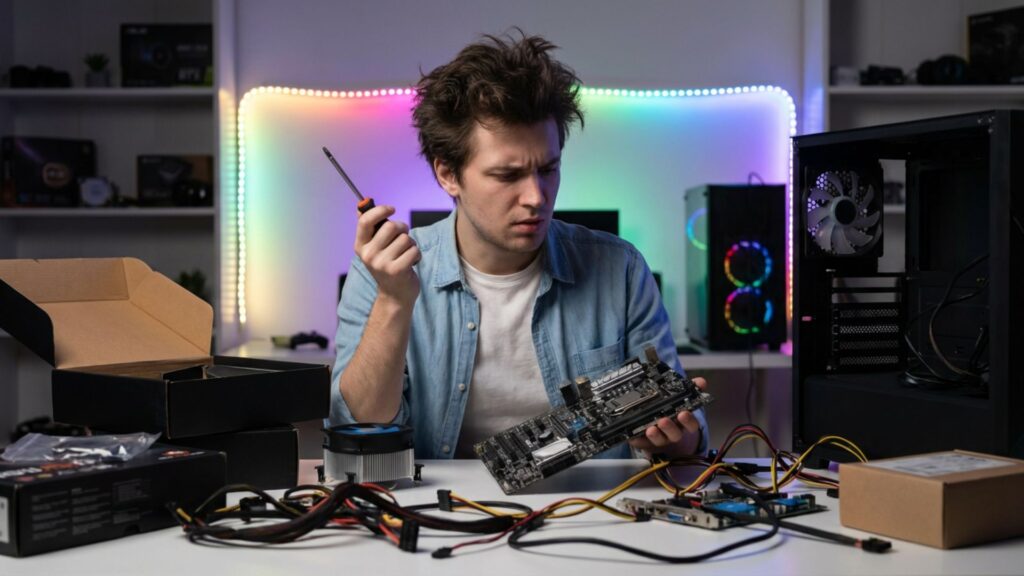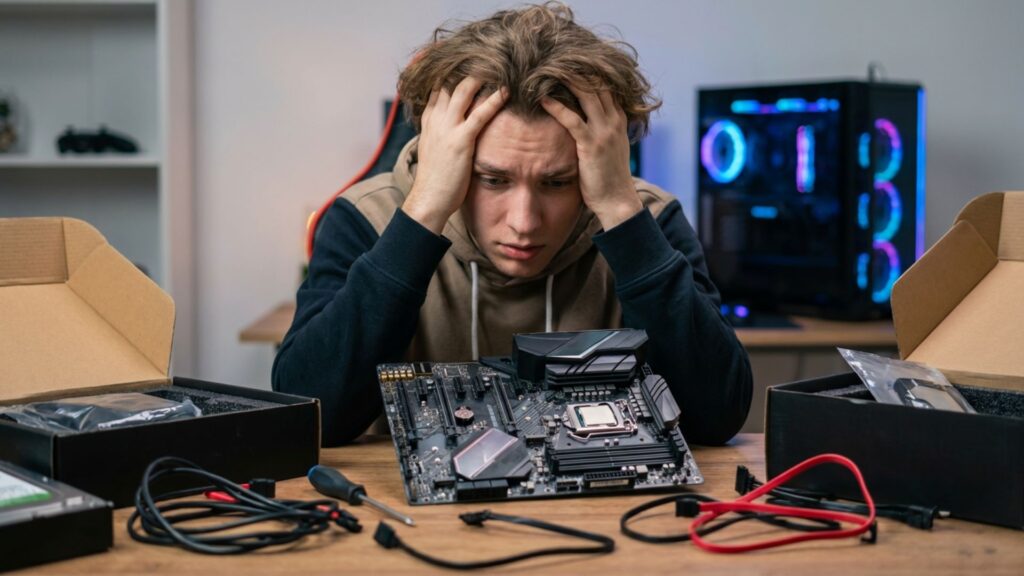Honestly, your motherboard is like the unsung hero of your PC. You don’t see it, but it controls everything from your CPU’s performance to how fast your RAM communicates, and whether your rig can actually survive future upgrades.
In this guide, I’m going to walk you through everything I’ve learned (sometimes the hard way) about choosing the right board. By the end, you’ll know how to pick a motherboard without the frustration I went through.
What is a Motherboard?

Here’s the thing: a motherboard is basically the glue holding your entire system together. CPU, GPU, RAM, storage drives, power supply they all talk through it. I didn’t realize this when I first built my PC, and I paid the price. The motherboard has key parts you need to know: the CPU socket, RAM slots, PCIe slots for your graphics card and other expansion stuff, power connectors, and the chipset that basically decides how everything talks to each other.
I remember one Friday night trying to install a new SSD and realizing my board only had one M.2 slot. Yeah… that was frustrating. For gamers, the quality of your motherboard can make or break performance, future upgrades, and overall system stability. Trust me, you don’t want to learn this the hard way like I did.
Key Features to Look for in a Gaming Motherboard
CPU Compatibility
Let’s be real if your CPU doesn’t match your motherboard, you’re screwed. I made that mistake once with an Intel 12th-gen CPU on an older LGA 1200 board. Didn’t even boot.
So, here’s the deal: Intel and AMD have different socket types, and you’ve got to pick one that matches your processor. Popular ones right now? LGA 1700 for Intel 12th and 13th gen, and AM5 for the latest Ryzen CPUs. If you buy the wrong one, you’re basically throwing money out the window. Learned that the hard way, as I said.
RAM Support
Here’s something people underestimate: RAM support. When I first built my PC, I bought 64GB of high-speed RAM thinking it would automatically run fast. Nope. My motherboard didn’t support the speed I wanted, so I had to manually tweak BIOS settings for hours. Painful.
A good gaming motherboard should support enough RAM, the right speed, and dual or quad-channel setups. Don’t just look at capacity speed matters. Frame rates can actually improve with faster RAM in some games, and your CPU will thank you.
Expansion Slots and Ports
Expansion slots are like insurance for your future upgrades. PCIe slots for GPUs, sound cards, or storage controllers these aren’t optional. And don’t get me started on USB ports. I once had 5 peripherals and only 3 ports. Chaos.
Look for boards with plenty of connections: USB, Thunderbolt, Ethernet—basically everything you think you might need now or later. I guarantee you’ll want them eventually.
Storage Options
I learned this the hard way too: never underestimate storage options. My first build had just one SATA port and one M.2 slot. By the time I wanted a second SSD, I had to swap drives and reinstall Windows. Nightmare.
A good gaming motherboard should have multiple M.2 NVMe slots and enough SATA ports. RAID support is a bonus if you’re into speed or redundancy. Knowing how many drives you can install and at what speed is part of figuring out what is a good motherboard for gaming.
Connectivity and Networking
I don’t know about you, but nothing annoys me more than lag in a battle royale. That’s why network support is huge. Modern motherboards have Wi-Fi, Bluetooth, and high-speed Ethernet built-in. Some even have gaming-optimized LAN chips or Wi-Fi 6 support. I had a game freeze mid-match because my old board couldn’t handle stable Ethernet speeds. Never again.
VRM Quality and Power Delivery
Voltage Regulator Modules (VRMs) might sound boring, but they’re crucial. They control the power your CPU gets. I learned this after overclocking my 5800X on a cheap board the system fried. Literally.
High-quality VRMs = stable power. Poor VRMs = crashes, throttling, instability. If you want to push your CPU, VRM quality is non-negotiable when deciding what is a good motherboard for gaming.
Types of Gaming Motherboards

Motherboards come in three main sizes: ATX, Micro-ATX, and Mini-ITX.
- ATX is full-size, with the most slots and connectivity. I love these for my main rig.
- Micro-ATX is smaller but still capable great if you want something compact without losing too many features.
- Mini-ITX is tiny. I tried this in a small build, and while it looked cool, I sacrificed a ton of ports.
Pick the size based on your setup and what you want to do. Personally, I won’t go smaller than Micro-ATX for a serious gaming rig anymore.
Budget vs High-End Gaming Motherboards
Motherboards are not cheap, but they don’t have to break the bank. My first board cost ₹18,000, and I regretted every rupee. Budget boards get the job done, they’ll run your CPU and GPU fine but may lack overclocking support and fancy features.
Mid-range boards are where I usually land: solid VRMs, good ports, and a couple of extras. High-end boards? Awesome if you want top-tier cooling, PCIe 5.0, RGB lighting, and durability but honestly, not always worth the price unless you’re going all out. When thinking about what is a good motherboard for gaming, balance your needs, budget, and upgrades. Don’t overspend on fluff.
Recommended Motherboards in 2025
For Intel builds, I’ve had great luck with Z790 and B760 boards; they just work and handle everything I throw at them. AMD folks? X670 and B650 boards are rock solid for Ryzen. Budget-wise, I usually stick with mid-range B-series boards they give you stability without emptying your wallet.
High-end? Yeah, if I’m building a serious rig with multiple GPUs and insane overclocking, I go for premium boards with robust VRMs, advanced cooling, and PCIe 5.0 support. Honestly, I’ve learned what is a good motherboard for gaming is not always about flashy features it’s about stability, expandability, and peace of mind.
Tips for Choosing the Right Motherboard

Match your motherboard with your CPU, GPU, and RAM sounds obvious, but I ignored this and wasted hours troubleshooting. Check future upgrades, read reviews (I spend at least 3–4 nights digging through forums), and focus on reliability. Ignore unnecessary features you won’t use RGB lights are fun, but they won’t improve your FPS. Core features matter. Always.
Common Mistakes to Avoid
So many gamers mess this up. Buying a board without checking CPU socket? Rookie mistake. Ignoring RAM speed limits? Been there. Choosing aesthetics over VRM quality? Painful. I have personally been guilty of all of the above. Learning the hard way. You don’t have to.
Conclusion
Look, I’ve tried at least ten different motherboards over the years. Some were nightmares. Some were game-changers. What is a good motherboard for gaming? It’s one that matches your CPU, has solid RAM support, stable VRMs, and enough connectivity for now and the future.
Personally, I stick with mid-range boards that hit all the practical marks. I’m not here for RGB alone. Your mileage may vary, but this is what I’d do if I were starting today. So, what about you? Which board has been your favourite or the one that made you pull your hair out? I’d love to hear your stories.
If you want to explore more guides and detailed comparisons on motherboards, check out our Complete Motherboard Guide | Types, Features, and Setup for PC Builders.
FAQs
What is the difference between a motherboard chipset and a CPU socket?
The CPU socket is where your processor physically sits, while the chipset controls how different components communicate. Think of the socket as the CPU’s home and the chipset as the traffic controller of your PC. Both affect compatibility and features.
Can I use any RAM with my motherboard?
Not exactly. Your motherboard supports certain RAM types, speeds, and maximum capacity. Using incompatible RAM may cause your PC not to boot or run slower. Always check the motherboard specifications before buying RAM.
How do I know if my motherboard supports overclocking?
Look at the motherboard’s chipset and VRM quality. Intel Z-series and AMD X/B-series boards usually allow overclocking. High-quality VRMs are essential for stable power delivery when you push your CPU beyond default speeds.
Is Wi-Fi built into all gaming motherboards?
No, not all boards come with Wi-Fi. Some only offer Ethernet. If you plan to use wireless internet, check for Wi-Fi 5/6 support. Some higher-end boards include gaming-optimized LAN chips for better online performance.
How many storage drives can a motherboard support?
It depends on the number of SATA ports and M.2 slots. Most mid-range boards have 4–6 SATA ports and 2–3 M.2 slots. High-end boards may support more drives, RAID configurations, and faster NVMe storage.
Can I upgrade my motherboard later without replacing other parts?
Sometimes. Upgrading usually requires a compatible CPU socket and memory type. Other components like GPUs and storage usually transfer fine, but you may need to reinstall your OS depending on the hardware changes.
Do smaller motherboards like Mini-ITX limit performance?
Not in raw performance, but they limit expansion options, cooling, and connectivity. You may have fewer PCIe slots, M.2 ports, or RAM slots. For small builds, you trade flexibility for compact size.
What is the role of VRMs in a gaming motherboard?
VRMs (Voltage Regulator Modules) control the power your CPU receives. Good VRMs ensure stable performance, especially during heavy gaming or overclocking. Poor VRMs can cause crashes, throttling, or damage to components.

